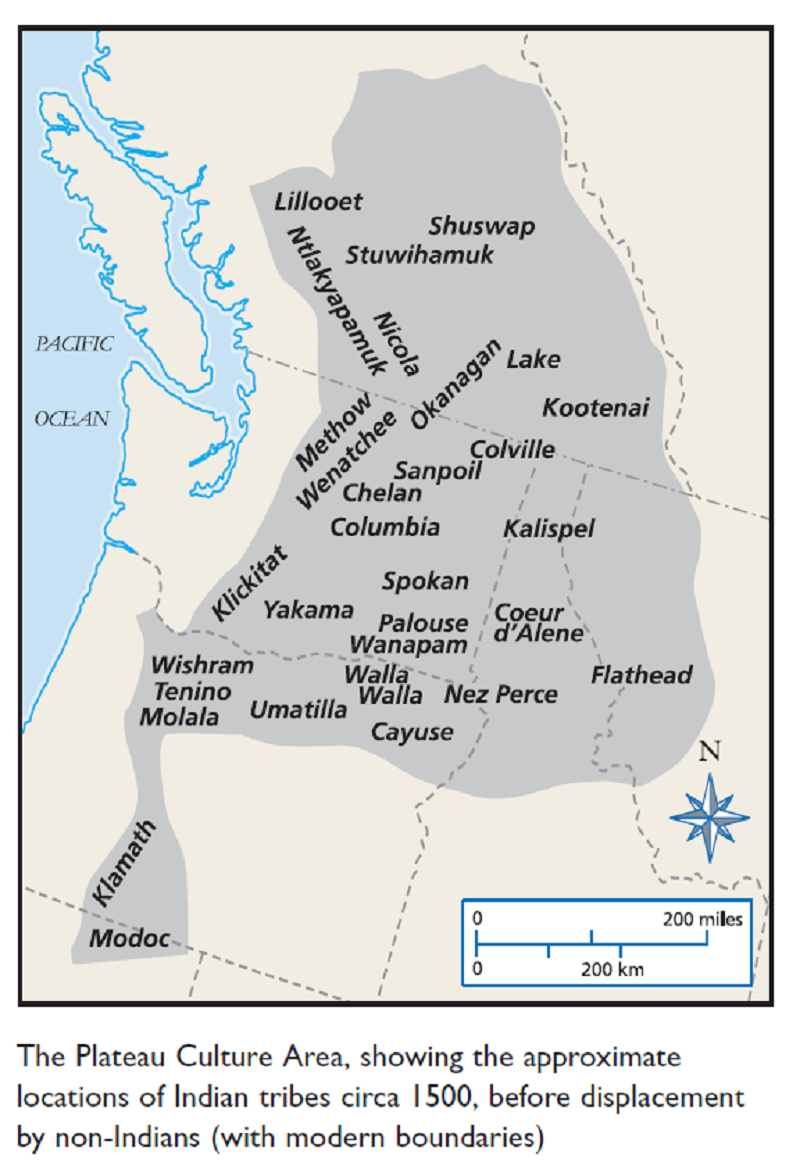
The Plateau Indians term is derived from the Columbia Plateau, a highland region through which the Columbia River flows. Spanning 1,200 miles and located in both the United States and Canada, the Columbia River is among the largest rivers in North America. It originates in the southeastern part of British Columbia and meanders to the Pacific Ocean, forming much of the border between Washington and Oregon. The river has numerous tributaries, including the Snake, Thompson, Okanagan, Deschutes, Umatilla, Willamette, and Kootenai Rivers. This system receives water from three mountain ranges — the Rocky Mountains, the Cascade Mountains, and the Coast Range. The Fraser River, another large river beginning in the Rocky Mountains in British Columbia, is not part of the Columbia watershed.
The Plateau Culture Area is located between the Cascades to the west and the Rockies to the east, bordered by the Fraser River to the north and the Great Basin to the south. This region covers territory currently mapped as southeastern British Columbia, eastern Washington, northeast and central Oregon, northern Idaho, western Montana, and a small part of northern California.
The mountains surrounding the Plateau region — the Cascades and the Rockies — capture a significant amount of rain and snowfall, resulting in a vast number of rivers and streams. These mountains and river valleys have enough precipitation to support some of the tallest trees globally, including evergreen forests of needle-bearing conifers such as pine, hemlock, spruce, fir, and cedar. The giant forests are too dense and shady for much smaller vegetation to grow beneath them.
The Columbia Plateau has minimal rainfall because the Cascades block rain clouds coming from the ocean. The land primarily consists of flatlands and rolling hills, with grasses and sagebrush as the dominant vegetation in this part of the culture area.
The sparse ground vegetation in both the mountain and plateau regions provided little game for the Native peoples living there. Some elk, deer, and bear could be found at the forest's edge, while antelope and jackrabbits inhabited the dry plains of the plateau. However, the abundant rivers and streams offered ample food, including various fish types and salmon that swam upriver from the ocean to lay their eggs. The river valleys also provided plentiful berries, such as blackberries and huckleberries. The plateau's grasslands provided other wild plant foods like roots and bulbs, particularly from the camas plant, a type of lily, as well as bitterroot, wild carrots, and wild onions.
Through fishing, hunting, and gathering, Plateau Indians could subsist without farming. In cold weather, most Plateau Indians lived in semi-underground, earth-covered pithouses along rivers, which provided natural insulation. In warm weather, they lived in temporary lodges with basswood frames and bulrush-mat coverings, either along the rivers during salmon-spawning time or on the open plains during camas-digging time. Plateau Indians also utilized the rivers as trade routes, fostering many contacts among different tribes.
The diverse dialects of Plateau tribes belong to two primary language families: Sahaptian (of the Penutian language phylum) and Salishan (of undetermined phylum affiliation). The Plateau Sahaptian-speaking tribes with individual entries in this book include the Nez Perce, Palouse, Umatilla, Walla Walla, and Yakama. Salishan-speaking tribes with individual entries include the Coeur d'Alene, Flathead, Kalispel, and Spokan. The Klamath and Modoc, two other Plateau tribes with entries, speak related dialects of the Penutian phylum, referred to by some scholars as the Lutuamian language.